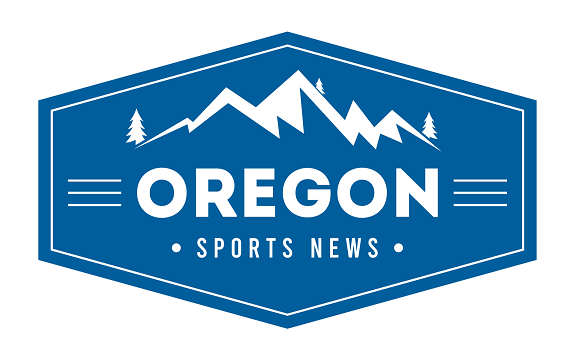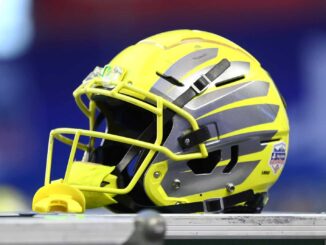
The Walter Camp preseason watch list rarely tells the whole story, but it does reveal where the spotlight is aimed. For Oregon, that spotlight now beams squarely on two of its offensive catalysts: quarterback Dante Moore and running back Makhi Hughes.
Their inclusion on the 2025 Walter Camp Player of the Year Watch List is more than just personal recognition—it’s a glimpse into the offensive identity Oregon is building in its second Big Ten season. Moore and Hughes represent not only headline talent but the system Oregon is crafting: a blend of quarterback control and ground-level power. In a league defined by trenches and toughness, the Ducks aren’t just adjusting—they’re asserting.
Dante Moore: From Return to Responsibility
Moore’s return to Oregon wasn’t simply about geography—it was about fit, opportunity, and leadership. After a year at UCLA that featured both promise and growing pains, his transfer to Eugene felt like a homecoming. Now, it’s become something bigger: a chance to lead from the front.
In spring practices and early fall camp, Moore has impressed with his poise, timing, and understanding of Will Stein’s system. This isn’t about development anymore—Oregon is building around him.
Moore’s edge isn’t just arm talent—it’s his command of tempo and ability to read defenses pre-snap. In a Big Ten landscape filled with shifting fronts and disguised coverages, that cerebral advantage matters. Oregon’s playbook is evolving—from tempo-heavy improvisation to more pro-style formations, layered passing concepts, and motion with purpose.
His Walter Camp nomination isn’t just a nod to past recruiting hype. It recognizes Moore’s real-time ability to elevate Oregon’s ceiling—and control games against the Big Ten’s best.
Makhi Hughes: Southern Toughness, Northern Utility
Hughes arrived from Tulane with more than stats—he brought credibility. He had proven he could handle volume, contact, and high-pressure reps. That made his transition into Oregon’s system nearly seamless.
In 2024, he didn’t rely on flash to earn respect. Instead, he delivered drive-extending runs, shed arm tackles, and turned routine plays into punishing sequences for opposing defenses. His presence fatigued linebackers and controlled the game flow. That style translates, especially in a league built around November matchups and physical fronts.
But Hughes isn’t just a workhorse. He’s a stabilizer. He balances Oregon’s tempo, sells play-action, and provides reliable pass protection. His role may not always light up highlight reels, but it powers everything Oregon wants to do offensively.
His spot on the watch list isn’t just about production—it’s about function. Hughes is the enforcer in Oregon’s evolving system.
A System Built for the Big Ten
Oregon’s 2024 move to the Big Ten was more than a conference shift—it was a real-time experiment in identity. Could a program built for speed and space survive in a league that prizes toughness and control?
Rather than compromise, Oregon refined. The 2025 offense reflects that philosophy.
Moore allows for quick-strike capability. Hughes provides the ability to grind down fronts. Tight ends like Jamari Johnson and Kenyon Sadiq offer formation versatility, while a strong offensive line—anchored by Immanuel Iheanacho and Dave Iuli—gives the unit a foundation built for control, not chaos.
Oregon doesn’t just want to keep up with Penn State and Wisconsin—they want to dictate the pace.
More Than Balance—It’s Complementary Aggression
Calling this a “balanced” offense doesn’t quite do it justice. It’s not 50/50—it’s 100/100. The run game and pass game don’t alternate. They amplify each other.
Moore’s comfort with intermediate routes attacks safeties. Hughes’ vision forces linebackers to pause, making play-action more effective. Every play builds pressure. If the defense crowds the line, Moore finds the seam. If safeties drop, Hughes gets a pull lead and goes downhill. It’s not about unpredictability—it’s about inevitability.
And this approach travels. Oregon isn’t just building for Autzen. They’re building for Camp Randall, the Horseshoe, and Kinnick. That’s why depth, conditioning, and discipline matter.
The Walter Camp Spotlight: A Reflection of Identity
Seeing both Moore and Hughes on the Walter Camp Watch List is symbolic. One represents renewed belief; the other, dependable grit. Together, they reflect Oregon’s evolving strategy—and signal what’s coming.
This isn’t a feel-good story about two transfers finding success. It’s a declaration of purpose. Dan Lanning isn’t chasing style points—he’s building a team that can win in November. Moore brings control. Hughes brings punishment. Together, they bring identity.
And now, with national recognition catching up to what Oregon insiders already suspected, the rest of the Big Ten has to adjust. Oregon isn’t asking to fit in. They’re preparing to take over.



